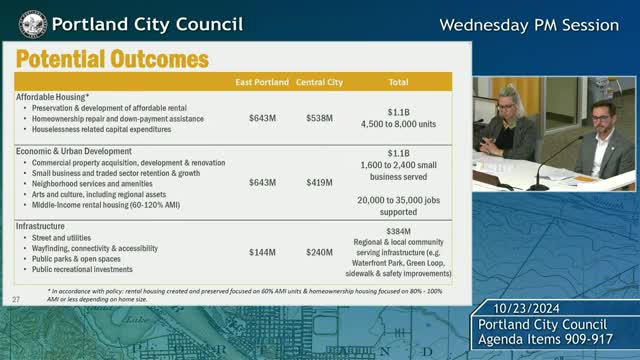City plans massive investment in affordable housing and jobs
October 24, 2024 | Portland, Multnomah County, Oregon
This article was created by AI summarizing key points discussed. AI makes mistakes, so for full details and context, please refer to the video of the full meeting. Please report any errors so we can fix them. Report an error »

In a recent government meeting, officials outlined ambitious plans for economic development and affordable housing in East Portland and the Central City, proposing significant investments that could reshape the region's landscape. The discussions highlighted a projected investment of approximately $1.1 billion aimed at creating up to 8,000 new affordable housing units, alongside support for small businesses and job creation.
The proposed financial framework includes the establishment of six new Tax Increment Financing (TIF) districts, which would necessitate amendments to two existing districts—the Central East Side and Lenztown Center. These amendments are designed to prevent overlap between the old and new districts, allowing for a streamlined approach to funding and development. The council's approval of these amendments is seen as a crucial step in facilitating the creation of the new districts.
The financial implications of these developments are substantial. Estimates suggest that the total foregone revenues for the City of Portland and other overlapping taxing jurisdictions could range from $1.6 billion to $2 billion over the next 30 to 35 years. This figure is based on projected annual growth in assessed property values and the anticipated issuance of long-term bonds to finance the projects. The city could face an annual impact of between $20 million and $24 million during the life of the districts.
Additionally, the impact on K-12 education funding is projected to be between $39 million and $48 million, with the state equalization formula expected to absorb much of this loss. The overall financial forecast indicates that while the initial years may see lower impacts as the districts begin to generate revenue, the financial burden will increase significantly as the projects near completion in the 2050s.
Despite concerns about the potential loss of property tax revenues, officials reassured that the new TIF districts would not completely offset the returns from expiring districts. Over the first decade, the city anticipates a net positive tax return of approximately $1.3 billion, although the new TIF districts will still influence future city budgets.
As the meeting concluded, officials emphasized the importance of these investments in fostering economic growth, enhancing infrastructure, and improving safety in East Portland, while also ensuring continued support for small businesses affected by the changes. The next steps will involve further discussions and planning to finalize the implementation of these initiatives.
The proposed financial framework includes the establishment of six new Tax Increment Financing (TIF) districts, which would necessitate amendments to two existing districts—the Central East Side and Lenztown Center. These amendments are designed to prevent overlap between the old and new districts, allowing for a streamlined approach to funding and development. The council's approval of these amendments is seen as a crucial step in facilitating the creation of the new districts.
The financial implications of these developments are substantial. Estimates suggest that the total foregone revenues for the City of Portland and other overlapping taxing jurisdictions could range from $1.6 billion to $2 billion over the next 30 to 35 years. This figure is based on projected annual growth in assessed property values and the anticipated issuance of long-term bonds to finance the projects. The city could face an annual impact of between $20 million and $24 million during the life of the districts.
Additionally, the impact on K-12 education funding is projected to be between $39 million and $48 million, with the state equalization formula expected to absorb much of this loss. The overall financial forecast indicates that while the initial years may see lower impacts as the districts begin to generate revenue, the financial burden will increase significantly as the projects near completion in the 2050s.
Despite concerns about the potential loss of property tax revenues, officials reassured that the new TIF districts would not completely offset the returns from expiring districts. Over the first decade, the city anticipates a net positive tax return of approximately $1.3 billion, although the new TIF districts will still influence future city budgets.
As the meeting concluded, officials emphasized the importance of these investments in fostering economic growth, enhancing infrastructure, and improving safety in East Portland, while also ensuring continued support for small businesses affected by the changes. The next steps will involve further discussions and planning to finalize the implementation of these initiatives.
View full meeting
This article is based on a recent meeting—watch the full video and explore the complete transcript for deeper insights into the discussion.
View full meeting
